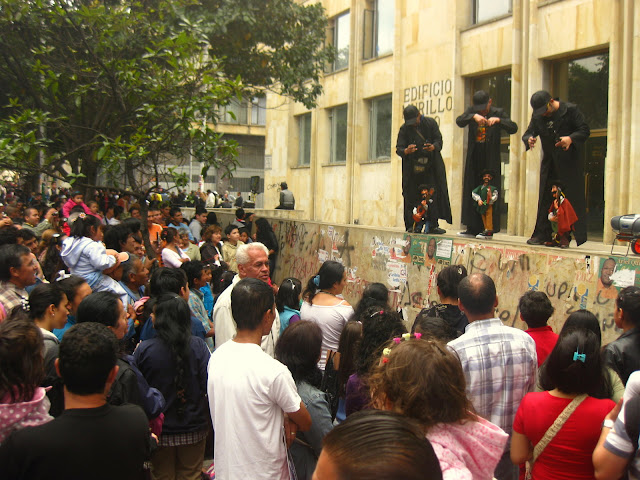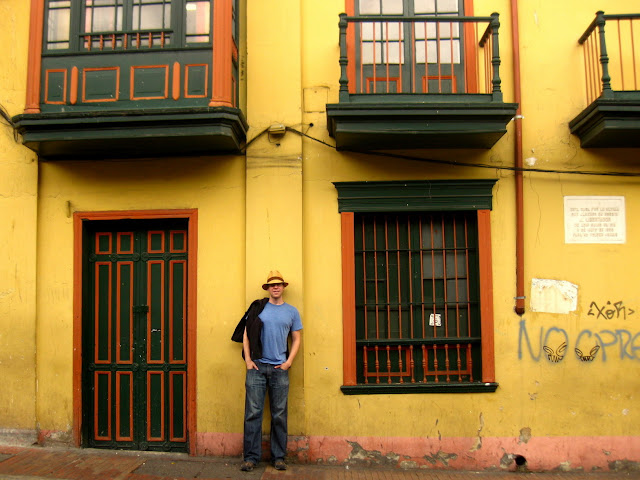 Mention to someone that you're planning on visiting Colombia and cynical admonitions may result. Dangerous guerilla movements. Random kidnappings. Widespread drug-related violence. These are the images that immediately spring to mind to many raised on a diet of sensationalist western media. Accordingly, I had no plans to visit Colombia before leaving for this latin journey. However, over the preceding seven and a half months, I had met so many travelers who raved about this diverse nation that I decided to swing by and check it out for myself. First stop: Bogotá.
Mention to someone that you're planning on visiting Colombia and cynical admonitions may result. Dangerous guerilla movements. Random kidnappings. Widespread drug-related violence. These are the images that immediately spring to mind to many raised on a diet of sensationalist western media. Accordingly, I had no plans to visit Colombia before leaving for this latin journey. However, over the preceding seven and a half months, I had met so many travelers who raved about this diverse nation that I decided to swing by and check it out for myself. First stop: Bogotá.By pure coincidence, I arrived in Colombia's enormous capital city at the start of the Semana Santa: the catholic holy week. During the daytime, the city center was overflowing with strolling pedestrians and street performers. It was a beautiful sight to see so many jovial people socializing on the streets, away from televisions and automobiles. In addition, every downtown church and cathedral had become a pilgrimage site. The crowds inside and out of these places of worship were immense.
By night, processions paraded through the elegant streets of central Bogotá. Regal marching bands announced the coming of cloaked worshipers carrying religious icons of Jesus and Virgin Mary.

 Most visitors to Bogotá choose to stay in the Candelaria, a historic neighborhood that winds up a hill overlooking downtown. Here, charming cobbled streets are flanked by tastefully painted and well-preserved old buildings. It really feels like you've stepped back in time when you amble through this tranquil part of the city. In fact, just experiencing this area of Bogotá alone merits a trip to Colombia.
Most visitors to Bogotá choose to stay in the Candelaria, a historic neighborhood that winds up a hill overlooking downtown. Here, charming cobbled streets are flanked by tastefully painted and well-preserved old buildings. It really feels like you've stepped back in time when you amble through this tranquil part of the city. In fact, just experiencing this area of Bogotá alone merits a trip to Colombia.
My hostel in the Candelaria was surprisingly full of guests when I checked in. Why were there so many visitors, I wondered? It turned out that in addition to arriving during the holy week, I also happened into the city during the International Theater festival, held in Bogotá once every two years. Dozens of locales throughout the capital had performances every night, given by troupes from Korea, France, Argentina, and everywhere in between. I invited Melissa, a lovely Bogotá native who I had met backpacking in Argentina, to join me for a show at the Plaza de Toros. The event was such a hot ticket that we resorted to scalping tickets on the street. As a large crane spectacularly lowered acrobatic thespians into the bullring in front of a packed house, I came to an unexpected realization: Bogotá is one of the major cultural capitals in all of Latin America.
Plaza de Toros
As if the plethora of plays that one could attend wasn't enough, every night during the festival it was also possible to see concerts by the finest musicians in all of Colombia. Under gigantic tents, energetic bands played to dancing crowds. Thrilling salsa bands, Afro-Colombian ensembles, and Latin rock stars lit up the stage until the wee hours. I made it to the tents for two nights, and was exposed to just a fraction of this country's rich musical heritage. But it was enough to convince me that when it comes to quality music, few countries can compete with Colombia.
It was a great feeling to leave Bogotá with my prior misconceptions replaced by something more positive. Colombians are eager to counter their country's negative image, and are generally very welcome to receiving foreigners. In fact, people here are almost overwhelmingly generous and polite. So the next time you hear an unfavorable comment on Colombia, know that the stereotypes of the past are different than the reality of the present. There's much more to Colombia than cocaine and coffee.
***















So jealous you were there for the theatre festival! Sounds an amazing place. Love your photos as always and can't wait to hear more about Colombia.
ReplyDeleteReally Great Place :)
ReplyDeleteme encanta que hayas estado tan feliz en Bogotá, me encantan las fotos (me debes varias)!!! un abrazo de la "lovely Bogotá native" :)
ReplyDeleteI havn't met a traveller who's had about thing to say about colombia either. Thanks for the post.
ReplyDeleteI loved your post... I was born in Colombia and I always look forward to going back :) its a magical place
ReplyDelete